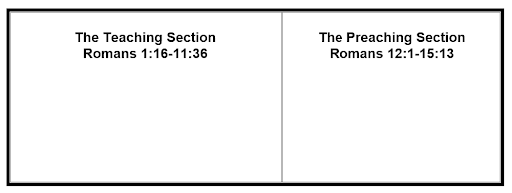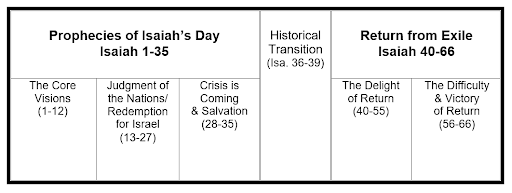
After you have prayed and prepared your heart to hear the biblical text, a good first step is to get the big picture of the passage you want to understand. First, get to know the content of the book or section of the book that the passage is in. Next, try to outline it.
Knowing the Content
We have a tendency to focus on small pieces of biblical text. We might memorize a verse or study a paragraph. That’s great to do, and we will look at passages in detail in the next lesson.
However, we are less likely to zoom out to see where a verse or passage fits in the bigger picture of a book of the Bible. For one thing, observing the big picture requires us to know more of the text and to be able to figure out what aspects of the text are most central to its meaning. This is an art, and it can take some practice! It is nice when our Bibles give us outlines and have sections with headings to help us. These were made by experts who have usually spent years studying that text.
The place to start is to read the text. The thought of reading a whole book of the Bible in one sitting might seem daunting, but it is usually easier than you think. You can read the whole Gospel of Mark in an hour and a half, especially if you use a dynamic translation that tries to use ordinary language (e.g.,The New Living Translation).
Types of Translation
- Formal equivalence translations: These stick as closely as possible to the original Greek or Hebrew wording and sentence structure without using bad English. E.g., NASB, NIV, NRSV, ESV.
- Dynamic equivalence translations: Also known as “functional” equivalence, these try to translate thought for thought more than word for word. Sometimes, these are considered to be better translations because they translate meanings. E.g., NLT, CEB.
- Free translations: Also known as paraphrases, these try to clarify meaning by rewording the text, often adding additional words or using modern idioms. E.g., Message, Passion.
Let’s say you want to survey the book of Philippians. A survey is a tool that helps you get the big picture of a book like Philippians and what it is mainly about.
The first step is to read through the book of Philippians several times, preferably in one sitting, preferably in more than one version. This can be hard because the temptation is to stop and admire the beautiful “trees” in the forest when the goal, at least in this case, is to get through the whole forest fairly quickly. We want to get into a helicopter and fly over the forest. The goal of a survey is to know the overall map of the city, not to know the lovely Greek restaurant on Center Street.
One way to get acquainted with the content of a book or section of a book (e.g., The Sermon on the Mount), is to give a title to each chapter, maybe even to write a sentence to help you remember what was there. You may know that the chapter divisions were not added until the 1200s, so they are not necessarily inspired. You are welcome to disagree with them!
However, the goal at this point is to get to know what’s in the text, and starting with the chapter divisions as they appear in your Bible is no problem. Try to make your titles inductive, meaning use language that’s actually in the chapter. Try to pick language that is fairly distinctive so that if you say “Love Chapter,” you will immediately think of 1 Corinthians 13.
Don’t worry about your title or sentence being comprehensive. The purpose of this exercise is to get to know what’s there. You don’t have to mention everything in the chapter.
How to Outline
It might be easy just to use whatever outline your study Bible has for a book of the Bible and go from there. However, you will take your Bible study to the next level if you start trying to make your own outlines. The very process of thinking through a possible outline gets you deeply into the text!
There are other reasons to make your own outline. For one, the experts themselves often disagree on the literary structure of a book (which is what an outline is). Scholarly outlines also can sometimes give more detail – show more trees – than we are looking for at this point. These details can be a distraction to seeing the big picture. An honest observer should never be ashamed to outline the text as it seems to be to them.
The key to discerning a good outline is 1) seeing how material sticks together and 2) seeing where there are transitions in the train of thought.
Above we mentioned the change of tone and topic that takes place at 2 Corinthians 10. By the same token, the material in 2 Corinthians 8-9 is all about the same topic – an offering that Paul was taking up for the Jerusalem Church. And we mentioned that 2 Corinthians 10-13 is all about Paul addressing those at Corinth who still reject his authority.
Material inside a section goes together. Genesis 1:1-2:3 plays out six days of creation and a seventh day to rest. It all goes together. Similarly, Genesis 2:4-3:24 all fits together because it is the same story in the same setting, the Garden of Eden.
Creating the Outline
Some transitions are obvious once you notice them. After Paul’s introduction, Romans 1-11 generally goes together. Then up to the conclusion, Romans 12-15 generally goes together. The argument of Romans has two big sections that we can even draw like this:

The old fashioned way of outlining might have used Roman numerals:
- The Teaching Section (Rom. 1:16-11:36)
- The Preaching Section (Rom. 12:1-15:13)
Outlining is certainly a skill that takes some practice, but the very process of outlining gets you more and more acquainted with the biblical text. Even if you are not confident, you will learn a great deal by trying. And until you feel confident, feel free to default to the outlines in your study Bibles and commentaries.
If you want to learn more about outlining, you can take Dr. David Smith’s entire course on how to study the Bible, a course with Kingswood University called “True^North.” In the meantime, here is an overall picture outline for the book of Isaiah. Remember, scholars sometimes disagree, especially on the details.

Notice how you can draw an outline to picture subdivisions as well as the main divisions. Here is how the outline above would look in a traditional format:
- Prophecies of Isaiah’s Day (Isa. 1-35)
- The Core Visions (1-12)
- Judgment of the Nations & Redemption of Israel (13-27)
- Crisis is Coming & Salvation (28-35)
- Historical Transition (Isa. 36-39)
III. Return from Exile (Isa. 40-66)
- The Delight of Return (40-55)
- The Difficulty & Victory of Return (56-66)